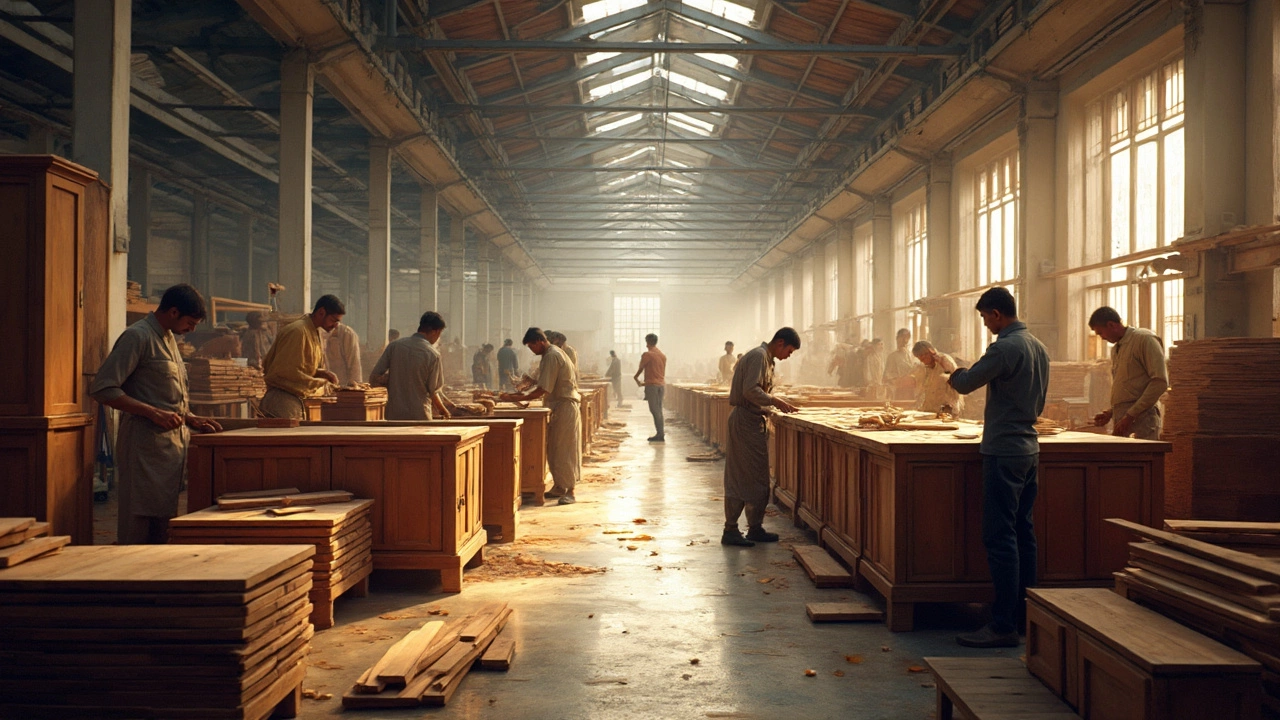
India's furniture market is like this vibrant tapestry of tradition and modernity. Ever wondered how the furniture in your home traces back to booming markets across India? It's not just about splurging on a fancy sofa; it's about understanding the dynamics shaping that purchase.
First off, let's talk about the most obvious players: the manufacturers. In India, these range from small family-owned workshops to large multinational companies, all crafting their way into homes both locally and abroad. For instance, Godrej Interio and Nilkamal are household names that have consistently delivered quality and innovation.
With modern trends like online shopping on the rise, companies like Urban Ladder and Pepperfry have turned heads with their tech-savvy approach. They've managed to blend style with convenience, making it easier than ever to buy furniture at the tap of a button. But who else is shaping this landscape? Let's break it down.
- Indian Furniture Market Overview
- Key Players in the Industry
- Trends Shaping the Furniture Sector
- Challenges Facing Manufacturers
- Future Prospects and Opportunities
Indian Furniture Market Overview
The furniture industry in India is a fascinating blend of historical artistry and cutting-edge design. It's grown into a multi-billion-dollar market, offering a diverse range of products catering to both local and export demands. Imagine the mix of traditional wooden carvings with sleek, modern minimalist designs - yes, that's India's furniture scene in a nutshell.
Market Dynamics
With a rapidly urbanizing population, the demand for contemporary home decor is skyrocketing. Urban households aren't just looking for basic wooden tables; they're hunting for style, comfort, and functionality all wrapped into one package. The influence of global trends is visible, yet the desire for traditional designs keeps the market uniquely Indian.
Considering digital growth, online sales have soared, making it a fiercely competitive space. Leading the pack are e-commerce giants like Amazon and Flipkart, alongside dedicated furniture platforms like Pepperfry and Urban Ladder. These online portals have widened reach, providing consumers access to a vast array of options without stepping out of their homes.
Local Production and Exports
Let's not forget local craftsmanship - a crucial pillar of India's furniture identity. Regions like Rajasthan, Kashmir, and Kerala are hubs of exquisite furniture production. Export markets are strong too, with countries like the US, UK, and UAE being major destinations for Indian furniture.
| Region | Main Products |
|---|---|
| Rajasthan | Wooden furniture, hand-carved pieces |
| Kashmir | Walnut wood carvings |
| Kerala | Wicker and cane products |
Investment Opportunities
With growing consumer demand and a push for sustainable materials, investors are eyeing this thriving market. It’s not all about big bucks; smaller players are innovating with eco-friendly materials and practices, which is a big hit with environmentally conscious consumers.
So whether you're in it for the heritage, the innovation, or the sheer diversity, the Indian furniture market is a dynamic landscape full of opportunities and surprises.
Key Players in the Industry
When we talk about the furniture industry in India, we're really talking about a mix of the tried-and-tested and the fresh and innovative. You see, this sector is filled with brands that have been around for decades, and some that are just getting their feet in the door. Let's take a look at who's who.
Big Wigs Making Waves
First up, there's Godrej Interio. Known for its durability and sleek designs, it's no wonder Godrej has been a favorite in Indian homes for years. They focus on sustainability without compromising on style. And with a massive range of products, they're well-equipped to furnish everything from offices to cozy homes.
Moving on to another giant, we have Nilkamal. This brand specializes in plastic furniture, which means affordability wrapped around innovation. They've been a game-changer for consumers looking for utility-driven designs without burning a hole in their pockets.
Innovative Upstarts
On the other end of the spectrum, there's the tech-savvy duo, Pepperfry and Urban Ladder. These brands aren't just about furniture; they're about reshaping how we shop. Their online-savvy approach allows customers to access everything from bean bags to classy sofas with just a few taps on their phones.
Both these companies have opened up experience centers to help people touch and feel products before buying. It's a clever blend of the online and offline shopping experience, ensuring that consumers get the best of both worlds.
Global Giants
Let's not forget about the global players making inroads into the Indian market. IKEA, the Swedish furniture powerhouse, made a splash with its first store in Hyderabad, offering trendy yet affordable furniture. Their unique DIY approach has captured the imagination of the Indian public, appealing especially to millennials who enjoy a hands-on approach to their homes.
Why These Players Matter?
Understanding the big names in the industry helps us grasp how diverse and dynamic the furniture market is in India. From embracing local craftsmanship to tapping into tech-driven sales, these companies collectively steer the industry. So, whether you're buying that new study table or a plush new sofa, odds are, it's one of these players catering to your need.

Trends Shaping the Furniture Sector
The furniture industry in India is buzzing with innovation and evolving consumer preferences. Let's dive into what's driving these exciting changes in the market!
The Rise of E-commerce
Gone are the days when buying furniture meant endless trips to physical stores. Now, companies like Pepperfry and Urban Ladder bring showrooms right to your screen. The convenience of comparing prices, styles, and brands online cannot be overstated. This shift to e-commerce is making furniture shopping more accessible than ever before.
Eco-Friendly and Sustainable Practices
Sustainability isn't just a buzzword—it's a growing demand. Many manufacturers are now prioritizing eco-friendly materials and practices. Recycling wood and using water-based finishes are becoming common. Consumers want to know that their furniture isn't just stylish, but also kind to the planet.
Customization and Personalization
Everyone wants their living space to reflect their personality, right? That's where customization comes into play. Indian manufacturers are offering options to personalize furniture, from fabric choices to modular designs. This trend is driven by the realization that one-size-fits-all just doesn't cut it anymore.
Ergonomic and Multi-functional Designs
With the rise of work-from-home setups, the demand for ergonomic furniture has skyrocketed. Desks and chairs that offer comfort and support for those long workdays are in high demand. Moreover, multi-functional furniture that saves space, like sofa beds or storage ottomans, is trending in urban areas where space is a luxury.
Smart Furniture
Technology is slipping into our homes as smart furniture. Imagine a nightstand with built-in wireless charging or a coffee table with a fridge drawer. These innovations are still emerging but are set to become mainstream soon.
All these trends highlight that the furniture market in India isn't static. It's a dynamic blend of tradition meeting cutting-edge technology and environmental consciousness. Keeping an eye on these trends can help consumers make informed choices and manufacturers stay ahead of the curve.
Challenges Facing Manufacturers
Running a furniture business in India isn't just about making beautiful products. Oh no, it's way more complex. Local manufacturers face a host of challenges that can make or break their ability to stay competitive in the vibrant furniture industry.
Supply Chain and Logistics
One of the first hurdles is logistics. With India's vast geography, getting products from A to B efficiently is no small feat. From raw material sourcing to final delivery, the complexities of transportation can inflate costs and delay timelines immensely.
"The logistics costs in India account for as much as 14% of the GDP, which affects every sector including furniture," says Prachi Patel, an industry analyst at Logistics Insight.
Many manufacturers are trying to innovate by integrating smarter tracking systems and optimizing delivery routes, but it's still an uphill battle.
Environmental and Sustainability Concerns
With the world turning towards sustainability, the pressure is on manufacturers to adopt eco-friendly practices. While customers are demanding more sustainable options, implementing those changes requires significant investment in technology and materials.
Some leading manufacturers are making headway, like using recycled wood or reducing emissions during production, but these efforts can be financially strenuous for smaller players in the Indian furniture market.
Competition and Market Dynamics
Let’s not forget the fierce competition. International giants peeking into the market mean local brands must constantly innovate to maintain their edge. They often find themselves balancing on a tightrope, deciding whether to focus on quality, price, or customization.
Adopting to these market dynamics requires agility and foresight, and not all businesses can pivot quickly enough, leading to potential losses.
- Material costs fluctuate regularly, affecting product pricing.
- Consumer preferences are evolving, demanding more variety.
- Urbanization is influencing design trends, pushing manufacturers to adapt.
Despite these challenges, many businesses remain resilient, finding new ways to thrive. By understanding these hurdles, companies can better strategize and perhaps lead the charge in shaping the future of India's furniture manufacturers.

Future Prospects and Opportunities
Looking ahead, the furniture industry in India seems poised for an exciting future. With a rapidly growing middle class and increased urbanization, the demand for modern and functional furniture is on the upswing. The market is expected to expand significantly in the next few years, and there's room for innovation and growth for both established companies and newcomers.
One big opportunity lies in sustainable furniture manufacturing. As environmental concerns become more pressing, consumers are leaning towards eco-friendly products. Manufacturers who can successfully integrate sustainable practices into their production will likely capture a larger market share. Think of using reclaimed wood, non-toxic materials, and energy-efficient processes—these are not just buzzwords but real game-changers.
Tech and E-commerce Integration
Another exciting prospect is the integration of technology. The rise of augmented reality (AR) apps lets customers visualize how a piece will look in their home before buying it. This immersive shopping experience is enhancing online sales. Plus, with e-commerce platforms like Amazon entering the fray, the accessibility to a variety of styles and brands has become easier than ever.
Customized and Multi-Functional Furniture
The demand for customized furniture is also gaining traction. People love personalized spaces, and companies that offer bespoke options are appealing to this niche market. Multifunctional furniture, which is ideal for smaller urban living spaces, adds another layer of appeal. Imagine a coffee table that doubles as a desk—super handy, right?
Furthermore, joint ventures and partnerships with international brands present another avenue for growth. Collaborating with well-known global names can help local manufacturers gain credibility and enhance their brand value.
In essence, the furniture market in India is not just surviving; it's thriving with opportunities. The blend of technology, sustainability, and customer-centric products is reshaping the industry. Companies that embrace these changes are likely to lead the way. So whether you're a business eyeing new ventures or a consumer looking for the next big thing in home décor, keep an eye on this ever-evolving landscape.